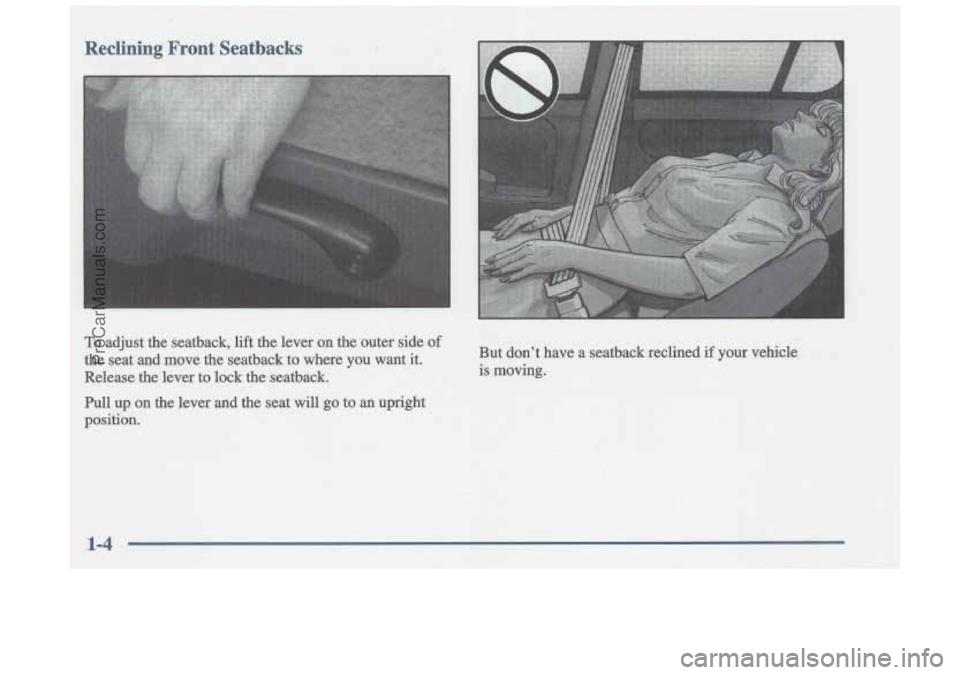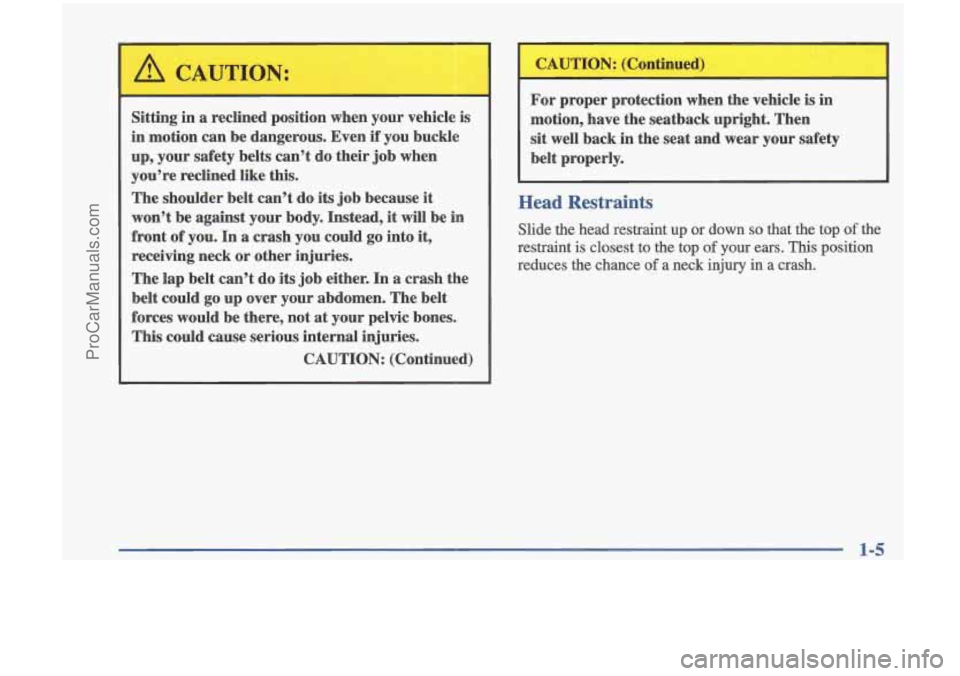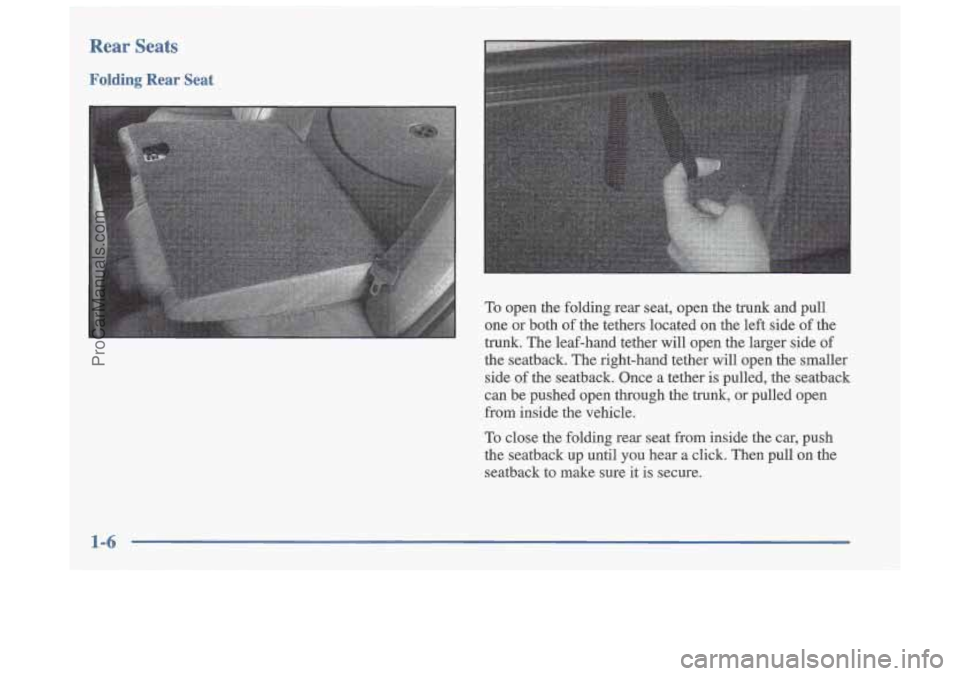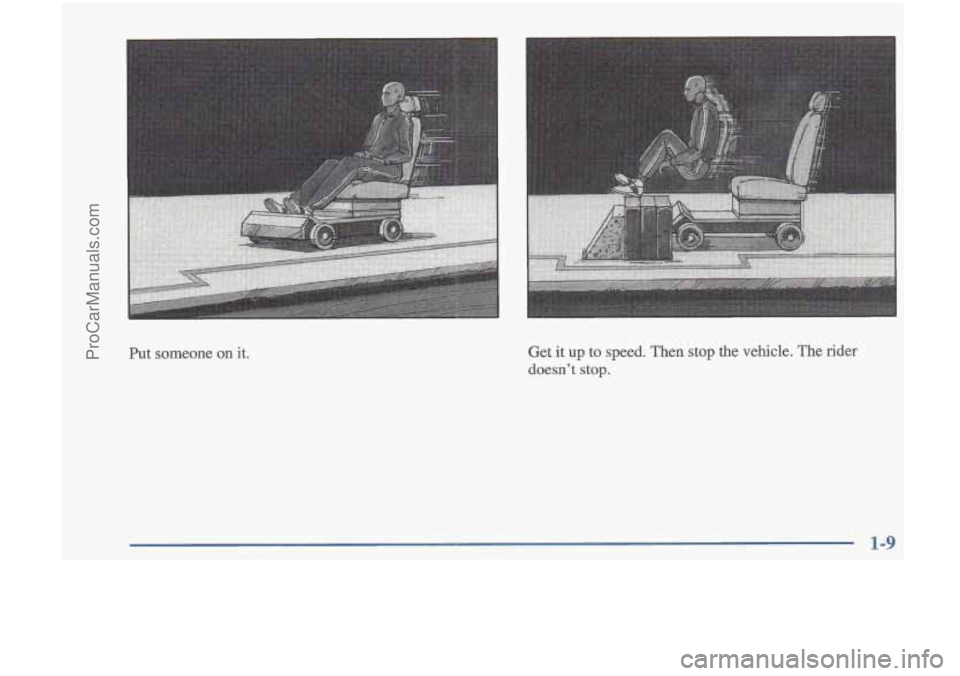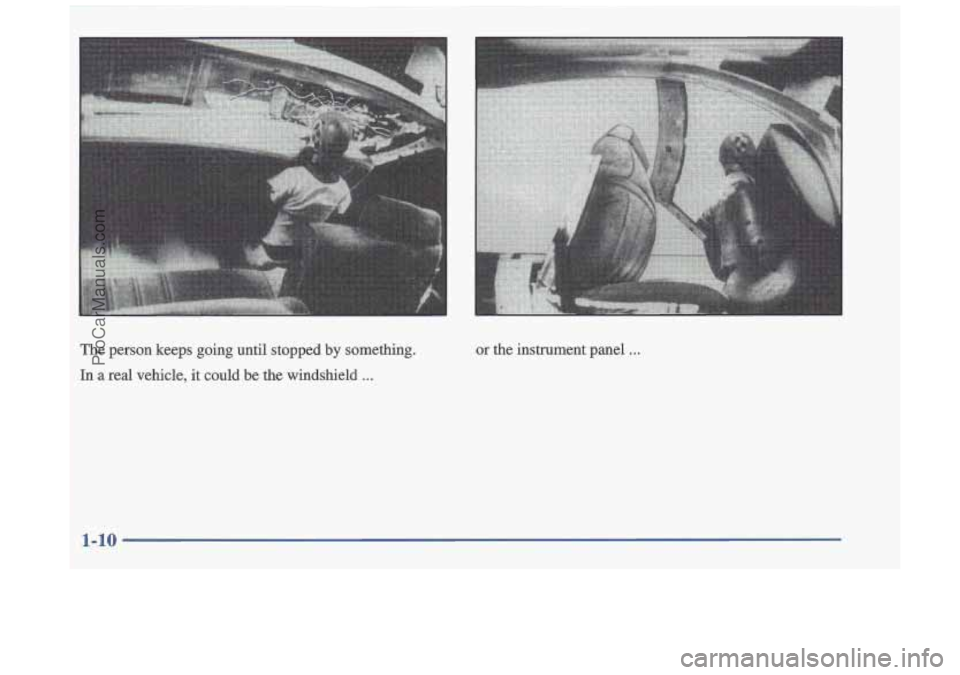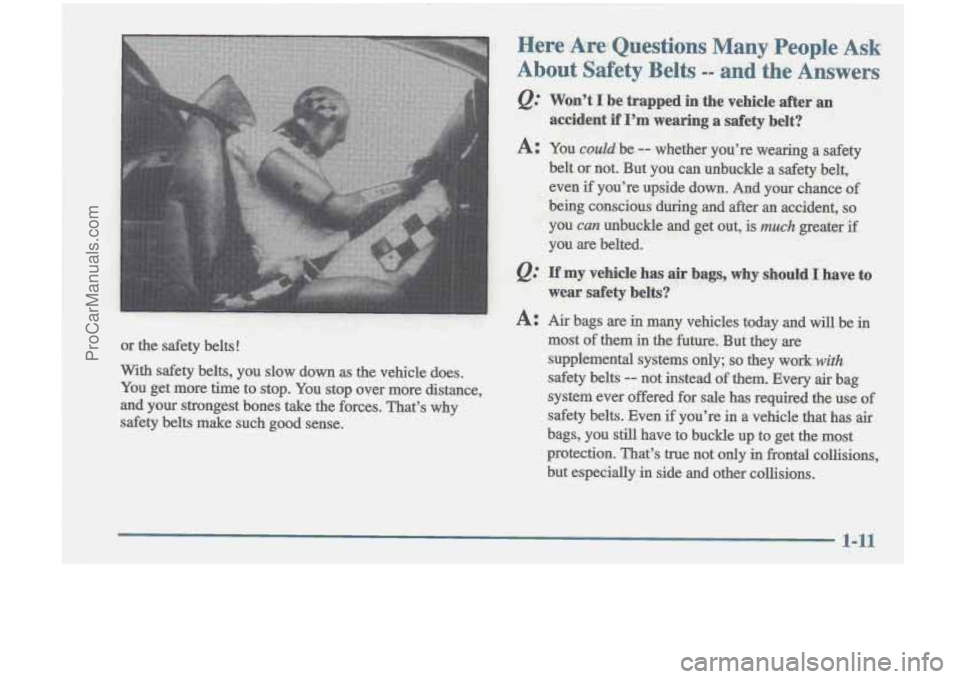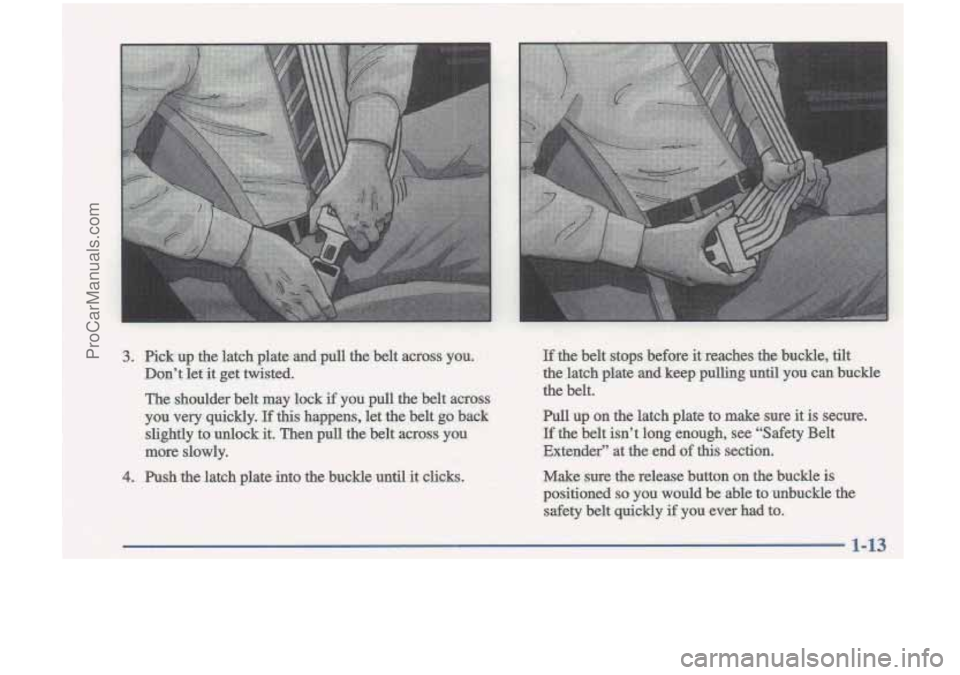OLDSMOBILE CUTLASS 1997 User Guide
CUTLASS 1997
OLDSMOBILE
OLDSMOBILE
https://www.carmanualsonline.info/img/31/58202/w960_58202-0.png
OLDSMOBILE CUTLASS 1997 User Guide
Trending: weight, turn signal, engine oil, steering, battery location, fuel reserve, seats
Page 11 of 353
Page 12 of 353
For proper protection when the vehicle is in
motion, have the seatback upright. Then
sit well back in the seat and wear your safety
belt properly.
Sitting
in a reclined position when your vehicle is
in motion can be dangerous. Even
if you buckle
up, your safety belts can’t do their job when
you’re reclined like this.
The shoulder belt can’t do its job because it
won’t be against your body. Instead, it will be
in
front of you. In a crash you could go into it,
receiving neck or other injuries.
The lap belt can’t do its job either.
In a crash the
belt could go up over your abdomen. The belt
forces would be there, not at your pelvic bones.
This could cause serious internal injuries.
CAUTION: (Continued)
Head Restraints
Slide the head restraint up or down so that the top of the
restraint is closest
to the top of your ears. This position
reduces the chance
of a neck injury in a crash.
1-5
ProCarManuals.com
Page 13 of 353
Rear Seats
Folding Rear Seat
To open the folding rear seat, open the trunk and pull
one or both of the tethers located on the left side of the
trunk. The leaf-hand tether will open the larger side of
the seatback. The right-hand tether will open the smaller
side
of the seatback. Once a tether is pulled, the seatback
can be pushed open through the trunk, or pulled open
from inside the vehicle.
To close the folding rear seat from inside the car, push
the seatback up until you hear a click. Then pull on the seatback to make sure it is secure.
ProCarManuals.com
Page 14 of 353
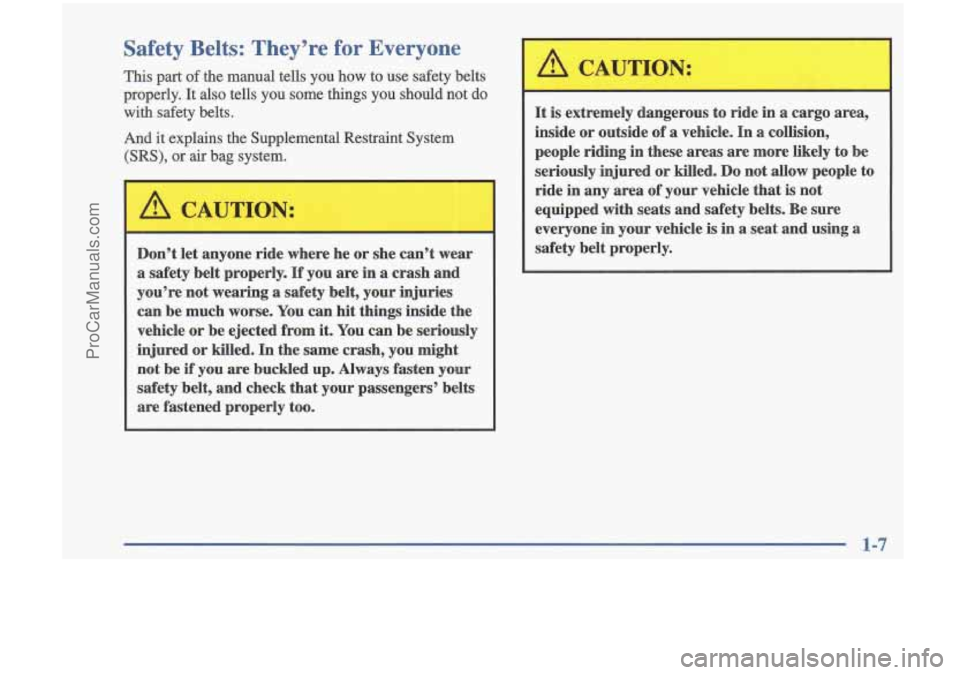
Safety Belts: They’re for Everyone
This part of the manual tells you how to use safety belts
properly. It also tells you some things you should not do
with
safety belts.
And it explains the Supplemental Restraint System
(SRS), or air bag system.
A CAUTION:
Don’t let anyone ride where he or she can’t wear
a safety belt properly.
If you are in a crash and
you’re not wearing a safety belt, your injuries can be much worse. You can hit things inside the
vehicle
or be ejected from it. You can be seriously
injured or killed. In the same crash, you might
not be
if you are buckled up. Always fasten your
safety belt, and check that your passengers’ belts
are fastened properly too.
-
A CAUTIO
It is extremely dangerous to ride in a cargo area,
inside or outside of a vehicle. In a collision,
people riding in these areas are more likely to be
seriously injured or killed. Do not allow people to
ride in any area of your vehicle that is not
equipped with seats and safety belts. Be sure
everyone in your vehicle is in a seat and using a
safety belt properly.
ProCarManuals.com
Page 15 of 353
Your vehicle has a light
that comes on as a reminder
to buckle up. (See “Safety
Belt Reminder Light” in
the Index.)
In most states and Canadian provinces, the law says to
wear safety belts. Here’s why:
They work.
You never know if you’ll be in a crash. If you do have a
crash, you don’t
know if it will be a bad one.
A few crashes are mild, and some crashes can be so
serious that even buckled up a person wouldn’t survive.
But most crashes are in between.
In many of them,
people who buckle up can survive and sometimes walk away. Without belts they could have been badly hurt
or killed.
After more than
25 years of safety belts in vehicles,
the facts are clear.
In most crashes buckling up does
matter
. . . a lot!
Why Safety Belts Work
When you ride in or on anything, you go as fast as
it goes.
Take the simplest vehicle. Suppose it’s just a seat
on wheels.
ProCarManuals.com
Page 16 of 353
Put someone on it. Get it up to speed. Then stop the vehicle. The rider
doesn’t stop.
1-9
ProCarManuals.com
Page 17 of 353
The person keeps going until stopped by something.
In a real vehicle, it could be the windshield ...
or the instrument panel . . .
1-10
ProCarManuals.com
Page 18 of 353
. , .. .,.. .. . . . .. ,
ProCarManuals.com
Page 19 of 353
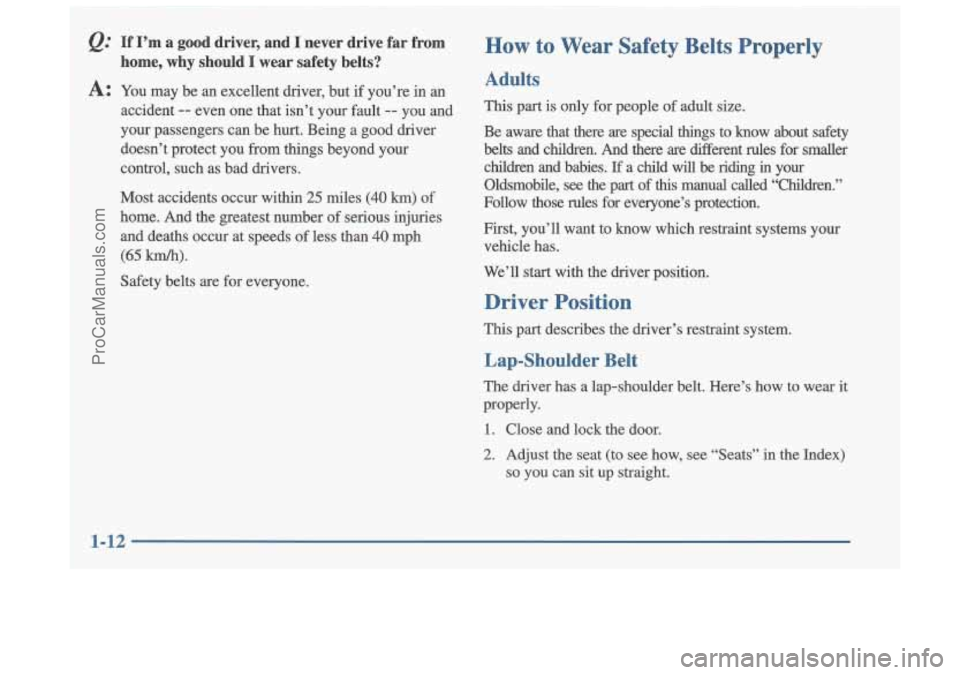
Q: If I’m a good driver, and I never drive far from
home, why should
I wear safety belts?
How to Wear Safety Belts Properly
A: You may be an excellent driver, but if you’re in an
accident
-- even one that isn’t your fault -- you and
your passengers can be hurt. Being a good driver
doesn’t protect you from things beyond your
control, such as bad drivers.
Most accidents occur within
25 miles (40 km) of
home. And the greatest number of serious injuries
and deaths occur at speeds of less than
40 mph
(65 km/h).
Safety belts are for everyone.
Adults
This part is only for people of adult size.
Be aware that there
are special things to know about safety
belts and children. And there
are different rules for smaller
children and babies.
If a child will be riding in your
Oldsmobile, see the part of
this manual called “Children.”
Follow those rules for everyone’s protection.
First, you’ll want to know which restraint systems your vehicle has.
We’ll start with the driver position.
Driver Position
This part describes the driver’s restraint system.
Lap-Shoulder Belt
The driver has a lap-shoulder belt. Here’s how to wear it
properly.
1. Close and lock the door.
2. Adjust the seat (to see how, see “Seats” in the Index)
so you can sit up straight.
1-12
ProCarManuals.com
Page 20 of 353
Trending: heater, headlamp, remote control, fog light bulb, child lock, octane, fuel tank capacity
